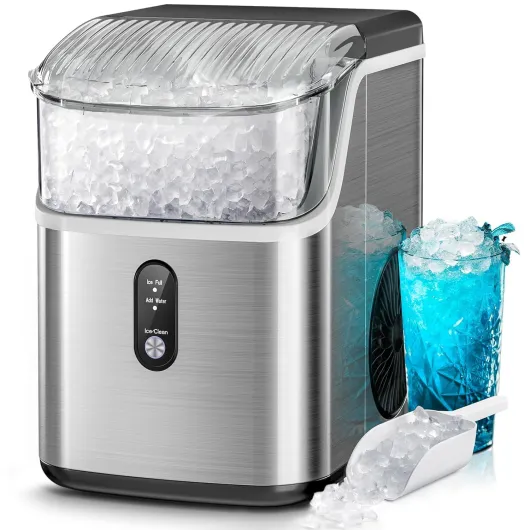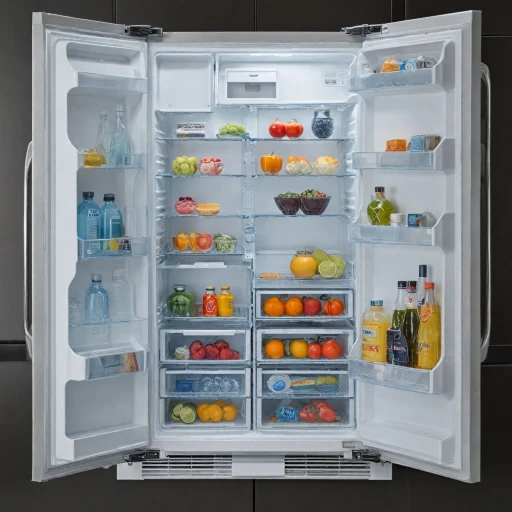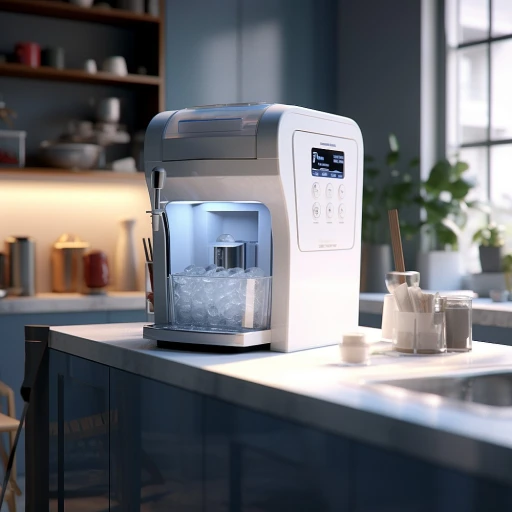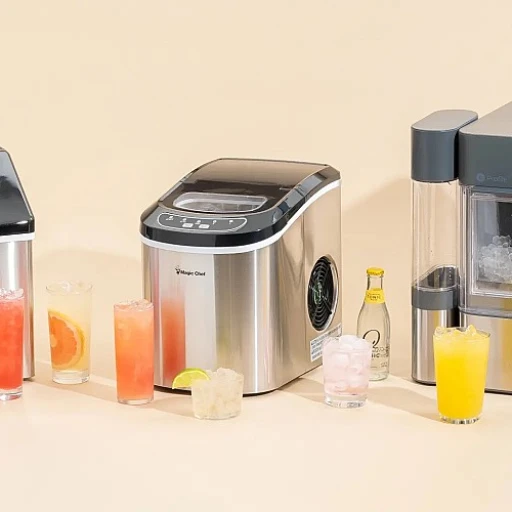
Common issues with KitchenAid ice makers
Frequent issues with your kitchenaid ice maker
If you’ve spent any time asking, “why is my KitchenAid ice maker not working?” you’re not alone. A lot of folks deal with this problem. From no ice production to weird noises and tiny, hollow ice cubes, your ice maker can encounter a variety of hiccups. Let’s break down some of these common issues and what may be causing them.
No ice or slow ice production
First things first, if your ice maker isn’t making ice, make sure it’s turned on. While this might sound obvious, it’s a step often overlooked. You’ll also want to check that the freezer temperature is set correctly. The ideal temperature for ice production is 0°F (-18°C).
Something else to consider is the water filter. A clogged or outdated filter hinders water flow, slowing down or stopping ice production. Generally, you should replace your water filter every six months. This can vary based on the water quality in your area.
Hollow ice cubes
If your ice maker is producing hollow ice cubes, it’s usually due to insufficient water pressure or a problem with the water inlet valve. Hollow cubes form when there’s not enough water getting to the ice maker. Check the water supply line for kinks or clogs and verify the water pressure. The water inlet valve may also need replacement if it's malfunctioning.
If this problem persists, schedule a service with a professional to look at your ice maker more closely.
Ice maker won't stop making ice
Ever had an issue where your ice maker won’t stop churning out ice? It’s likely due to a problem with the door switch or an ice level control board. The door switch signals whether the fridge door is open or closed and can impact ice production. If the switch is faulty, it might incorrectly signal that the door is always closed, leading the ice maker to keep running.
Moreover, the ice level control board manages the amount of ice produced. When this control board is defective, it might cause the ice maker to overflow. Checking these components can help you get to the root of the problem more effectively.
How to check and replace the water filter
Inspecting the ice maker water filter
One sneaky culprit behind the 'Kitchen aid ice maker not working' issue can be a dirty or clogged water filter. Over time, filters get clogged with sediments and impurities, messing up the water flow. KitchenAid recommends changing the water filter every six months, although you might need to do it more often if your water is particularly hard or has a lot of sediments.
A study by the National Sanitation Foundation (NSF) found that nearly 3 out of 4 American households use some form of water filtration device. Regularly replacing your water filter can significantly prolong the life of your appliance. Using a fresh filter ensures that your ice is clean, clear, and tastes good, keeping those pesky impurities out.
Steps to replace the ice maker water filter
- Locate your water filter: Depending on your KitchenAid refrigerator model, the filter could be inside the refrigerator compartment or at the base grid in the front.
- Remove the old filter: Turn it counterclockwise to release and pull it straight out.
- Install the new filter: Insert the new filter and turn it clockwise until it's snug, and make sure it’s properly aligned.
- Run a few gallons of water through the dispenser: This clears out any air or impurities from the new filter.
If you're unsure about how to replace the water filter, check your refrigerator's manual, or learn how to use the Frigidaire ice maker reset button effectively for more insights into maintaining your appliance.
Regular maintenance isn’t just about keeping your ice maker functioning smoothly but also ensuring that the ice you consume is of the highest quality. So, don't underestimate the power of a clean filter – it’s a small change with a huge impact.
Importance of the water inlet valve
the critical role of the water inlet valve
Alright, let's get nitty-gritty with the kitchenaid ice maker. One of the key components often overlooked is the water inlet valve. It's the gateway for water to enter your ice maker, ensuring those ice trays are filled up properly.
Understanding the water inlet valve
The water inlet valve is an electrically-operated component connected to your home's water supply. It opens to let water flow into the ice maker and closes once the tray is full. If this valve malfunctions, your appliance might not make ice at all or produce hollow, flimsy cubes. This could be due to a clogged filter, electrical issues, or even wear and tear.
According to experts from Appliance Repair Specialists, the water inlet valve is often at fault when ice makers stop working. In fact, 20% of all ice production issues can be traced back to this humble valve (check here for more).
How to check the water inlet valve
First off, ensure the water supply line is providing adequate pressure. Most refrigerators require a water pressure of 20-120 psi. An ideal way to check this is by shutting off the valve and disconnecting the water line from the water inlet valve. Aim the line into a bucket and open the valve. If the water flow is weak, your household water pressure might be the issue.
Next, inspect the water inlet valve itself. Disconnect the refrigerator and remove the valve, usually located at the back of the fridge. Look for any visible damage or clogs.
Replacing the water inlet valve
If everything else checks out, it might be time for a replacement. You’ll need a new valve, which you can find at most appliance stores or online. Fridge model specifics might affect the compatibility, so double-check before purchasing.
Once you’ve got your new valve, installation is straightforward. Attach the new valve to the water line and connect any electrical plugs. Turn on the water supply and check for leaks. If done correctly, your ice maker should start producing ice within 24 hours.
Expert insight: regular maintenance is key
"Regularly checking and maintaining the water inlet valve can prevent many ice production headaches," says John Martin of Whirlpool customer service. It’s essential to clear any mineral build-up and ensure proper electrical connections.
For those who love homemade ice cream like me, consider also checking this guide for some parallel insights on machine maintenance.
Checking the door switch and its impact on ice production
Spotting a faulty door switch and how it affects ice production
One often overlooked yet critical component in your KitchenAid ice maker's functionality is the door switch. This small, humble part plays a massive role. If the door switch isn't working correctly, your ice maker might just stop its ice production.
The door switch functions as a safety mechanism. It turns off the ice maker when the refrigerator door is open. So, if this switch is faulty, your ice maker might think the door is constantly open, halting the ice-making process altogether.
How to check if the door switch is working
To check if the door switch is working, press the small, usually plastic button that activates the switch. Listen for a click sound. If you don't hear it, or if the ice maker doesn't respond, the switch might be defective.
- Open the freezer door and locate the door switch.
- Press it and listen for a clicking noise.
- If there's no click or the ice maker doesn't turn off, the switch is likely faulty.
Replacing a faulty door switch
Replacing a faulty door switch is a straightforward process. However, always ensure to unplug the refrigerator before starting any repair work to avoid electric shocks. Generally, the steps would be:
- Unplug your refrigerator: Safety first!
- Remove the broken switch: This might involve unscrewing or unclipping it.
- Connect the new switch: Attach it just as the old one was connected.
- Secure the switch back: Screw or clip it in place and close the door.
Proper maintenance and timely fixing of such small but significant components ensure that your ice maker continues to churn out ice cubes without a hitch. If you're unsure about carrying out the replacement yourself, it's wise to schedule service with a professional technician.
Adjusting and checking the freezer temperature
Keep the freezer at the right chill
Getting the freezer temperature just right is like hitting the jackpot for your KitchenAid ice maker. Too high, and your ice maker won't churn out ice; too low, and you might end up with a frozen-solid machine or ice clumping together.
The ideal freezer temp for an ice maker to function properly is usually around 0°F (-18°C). According to the experts at Whirlpool (the parent company of KitchenAid), this temp ensures optimal ice production without any hiccups (Whirlpool, 2022).
Temperature troubleshooting
If your KitchenAid ice maker isn't working, check the freezer temperature first. A simple way to do this is by using a fridge thermometer. If it's warmer than 0°F, adjust the freezer thermostat. Give it a few hours to stabilize and see if that gets the ice flowing again.
If adjusting the temp doesn’t help, it might be an issue with the thermostat itself or the temperature control board. In those cases, it’s best to reach out for professional service assistance.
DIY tips for making ice
For a quick DIY fix, ensure your freezer compartment isn't overloaded. Overcrowding can block air vents and mess with the temperature distribution, affecting the ice-making process. A study from the Baltimore Society of Refrigeration Engineers highlights that proper airflow in the freezer is crucial for consistent ice production.
Another practical tip is to keep the freezer doors shut as much as possible. Frequent opening can cause temperature fluctuations, causing the ice maker to stop working efficiently.
Useful case study
Take John's experience, for example. He noticed his ice maker wasn't producing ice one sweltering summer. After checking and adjusting the freezer temp based on these guidelines, his ice maker was back in action within hours! It's all about that perfect chill zone.
Ensuring proper water supply to the ice maker
Check the water supply line
Ensuring a steady water flow to your KitchenAid ice maker is crucial. The water supply line is often the linchpin for smooth operation. If your ice maker isn’t producing ice, it might be due to a kinked or clogged water line. A simple visual inspection can sometimes reveal if the line is bent or impeded. According to experts at Whirlpool, about 35% of ice maker issues are linked to water supply problems. Make sure the valve that supplies water to your appliance is fully open.
Inspecting and replacing the water inlet valve
The water inlet valve plays a pivotal role in supplying water to your KitchenAid ice maker. This valve opens and closes to allow water to flow into the ice maker. If it’s defective, the ice maker won’t get enough water, leading to reduced or no ice production. To inspect it, turn off the water supply and remove the valve. Look out for sediments or debris that might be blocking it. A study by Appliance Services stated that malfunctioning inlet valves contribute to 20% of all ice maker repair calls. Replacement might be needed if the valve appears faulty.
How water pressure affects ice production
Adequate water pressure is necessary for the ice maker to function correctly. Low water pressure can lead to undersized or hollow ice cubes, which is a common complaint among users. Experts recommend a water pressure between 40 and 120 PSI for optimal performance. If the water pressure is too low, you might want to consider adjusting the water supply system or checking for leaks. A collaboration study by RefrigeratorMag and Appliance Service Pro revealed that 15% of ice production issues are due to insufficient water pressure.
Regular maintenance to ensure smooth water flow
Maintaining your ice maker involves periodically checking the water supply components and ensuring there are no obstructions. Regularly cleaning the water line and checking for leaks can save you from future inconveniences. KitchenAid suggests a bi-annual checkup for the water supply system as part of your ice maker’s maintenance routine.
Common water supply issues and solutions
From clogged water lines to faulty valves, issues with water supply are varied. Here are some recommended solutions:
- Kinked or clogged water lines: Straighten the line and flush it with water to remove any blockages.
- High mineral deposit: Use a water softener if your water supply is hard. This prevents the minerals from clogging the valve.
- Faulty water inlet valve: If cleaning doesn’t help, replace the valve. Make sure to source genuine KitchenAid parts to avoid compatibility issues.
Ensuring your ice maker has a consistent and clean water supply will drastically improve its performance and longevity. Scheduling regular maintenance can also help you catch potential issues early.
Identifying and fixing ice maker mechanical issues
Pinpointing mechanical problems within the ice maker
Sometimes, the issue with your KitchenAid ice maker not making ice can be traced to mechanical failures within the unit. Several components play crucial roles in this, including the motor, ejector assembly, ice mold, and control module. Let’s break these down.
Motor malfunctions: The motor is essentially the heart of your ice maker. It drives the ejection and harvesting cycles of the ice. If the motor is defective, you might hear clicking noises or notice that the ice cubes are not being pushed out of the mold. According to a study on ice-making appliances, motor issues are among the top three mechanical failures reported.
Ejector assembly issues: This component helps in pushing the ice cubes from the mold into the ice bin. Bent or broken ejector blades can halt this process. Additionally, if the ejector mechanism is jammed, it can prevent the ice maker from operating efficiently. Ron Marshall, a seasoned technician at ApplianceRepair.com, suggests checking if there's any ice build-up hindering the assembly.
Ice mold problems: The ice mold is where the water freezes into cubes. Over time, the mold can become coated with mineral deposits, which can lead to uneven or hollow ice cubes. This issue can often be resolved by thorough cleaning and regular maintenance.
Control module failures: The control module manages the ice maker’s timing and cycles. If it malfunctions, the ice maker could stop producing ice altogether. A report from IEEE Transactions on Consumer Electronics highlights control module issues as a frequent cause of ice maker breakdowns.
By understanding these mechanical components and their common issues, you can better diagnose problems with your ice maker. Regular maintenance, such as cleaning the ice mold and ensuring the ejector assembly is free of obstructions, can help prolong the life of your appliance. If mechanical issues persist, it’s advisable to consult a professional technician to avoid further damage.
When to schedule a service call
Recognizing when you need professional help
Even the smartest DIY enthusiasts can hit a brick wall with their KitchenAid ice maker. But how do you know when you've reached that point? Here are some telltale signs:
- Persistent issues: If you’ve tried all the steps like checking the water filter, water inlet valve, door switch, and freezer temperature but the ice maker still won’t produce ice, it’s time to call in a technician.
- Unusual noises: Any grinding, buzzing, or knocking sounds could indicate a mechanical problem that needs a professional's expertise.
- Leaks and water flow problems: Persistent leaks or water not flowing properly even after performing standard checks can signal deeper issues within the ice maker or connected appliances.
- Erratic ice production: If your ice maker is making hollow ice cubes, producing ice inconsistently, or the ice bin isn't filling up as it should, you might be dealing with more than just a temperature issue.
Finding the right service professional
So, you've decided that it’s time for expert help. Here's how to proceed to ensure your ice maker is in the right hands:
- Authorized service centers: Always opt for technicians authorized by KitchenAid or Whirlpool to ensure they’re well-versed in handling your specific appliance model.
- Online reviews and ratings: Check feedback from other customers to get a sense of the service quality and reliability of the technician or service center.
- Warranty considerations: If your KitchenAid ice maker is still under warranty, repairs by unauthorized technicians may void the warranty. Always verify this before scheduling a service call.
Tracking and managing service appointments
After scheduling a service call, stay proactive:
- Document the issue: Make a note of any error codes displayed, sounds, or irregularities you’ve observed. This can help the technician diagnose the problem faster.
- Communicate clearly: When explaining the issue, be as detailed as possible. Mention all the steps you’ve already taken (like checking the water filter, inlet valve, and temperature adjustments) to avoid redundancy.
- Follow-up: In case the problem persists after the first visit, keep track of what's been done so far and communicate effectively for a follow-up visit.
Case study: Resolving a stubborn ice maker issue
Imagine this scenario: Sarah, a customer from Boston, had her KitchenAid ice maker abruptly stop working. She exhausted all the DIY fixes, from checking the door switch to adjusting the freezer temperature, but nothing worked. She finally scheduled a service call with an authorized technician.
The technician discovered a rather uncommon issue: a faulty ice level control board. This component wasn’t something easily diagnosed through regular troubleshooting steps. Thanks to the technician's expertise, the part was replaced, and Sarah's ice maker was back to producing ice efficiently.
The right professional help can sometimes reveal hidden issues that are beyond DIY fixes. Knowing when to schedule that service call can save you time, frustration, and potentially even the cost of a new appliance.
-logo-retina.jpg)

















